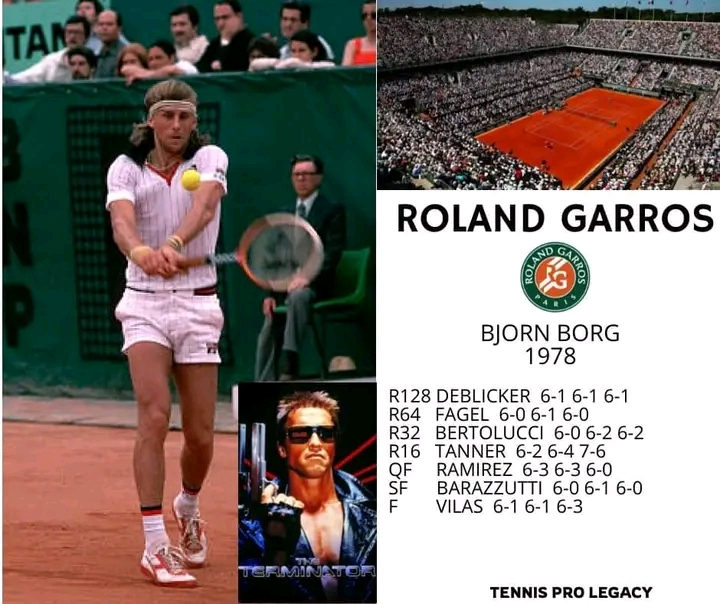Borg didn’t lose a set, he only lost 32 games during the whole tournament! King!!…..
The summer of dominance in tennis history has countless chapters, but few stand as tall as the story of Björn Borg’s imperious sweep on the hallowed courts of Wimbledon. The ice-cold Swede, already a phenomenon in the sport, carved his name deeper into history by producing one of the most complete performances ever seen at a Grand Slam tournament. Over the course of two weeks, Borg didn’t just win matches—he dismantled opponents with surgical precision, refusing to drop a single set and conceding only 32 games across the entire championship.
In an era when the grass court demanded serve-and-volley artistry, Borg dared to be different. His metronomic baseline game, built on deep, relentless topspin and unshakable focus, defied conventional wisdom and tore through opponents who had spent their careers perfecting quick attacks at the net. Yet match after match, Borg turned Wimbledon’s quick lawns into his own kingdom. The numbers from that campaign still look unreal: straight-set victories in every round, barely allowing rivals to breathe, let alone steal momentum. By the end, 32 games lost felt less like vulnerability and more like a minor statistical footnote in an otherwise untouchable masterpiece.
To fully appreciate the scale of his dominance, consider the caliber of competition he faced. Borg didn’t pad his record against journeymen; he swept aside established contenders and dangerous challengers. Each round posed new threats—power servers, crafty volleyers, fiery baseliners—but the Swede seemed immune to pressure. His unflappable demeanor, famously dubbed “Ice Borg,” was more than a nickname. It was a weapon. As opponents grew frustrated by his consistency and uncanny ability to retrieve every ball, Borg’s calm presence only grew stronger.
The Wimbledon crowd, steeped in tradition and usually reserved in their admiration, couldn’t hide their awe. They knew they were witnessing something historic: a young man at the peak of his athletic gifts, rewriting what was possible in tennis. Fans had grown used to champions dominating, but this was different. Borg wasn’t just winning; he was redefining efficiency, playing the game with a minimalism that bordered on perfection. His blend of physical endurance and mental clarity transformed each match into a ritual of inevitability.
Coaches and analysts often highlight Borg’s stamina, his unmatched fitness levels that allowed him to maintain high intensity across long rallies. But during this particular Wimbledon, the truth is he rarely needed to test his endurance. Matches were over before opponents could settle in. With scores like 6-1, 6-2, 6-3 becoming routine, Borg shortened contests not by rushing points but by erasing errors. He didn’t gift away free games, he didn’t wobble under the spotlight. The Swede kept his foot on the accelerator until the very last ball.
By the time Borg reached the championship match, the narrative wasn’t about whether he could win. It was about how ruthlessly he would finish the job. And finish it he did, in a final performance that cemented his legacy. The scoreboard read clean lines of straight sets yet again, as though carved into the grass with inevitability. When the last point was struck, the applause rang not just for another Wimbledon champion, but for a king who had ruled without flaw.
Statisticians scrambled to frame the numbers. No sets dropped. Just 32 games lost across the entire tournament. For context, most champions, even the greatest, often grind through five-set marathons, suffer through tie-breakers, and surrender pockets of momentum. Borg allowed none of it. His campaign was not a fight for survival but a coronation stretched across two weeks.
For Borg himself, characteristically modest in victory, there was no self-congratulation. He accepted the trophy with his trademark calm, thanking the crowd, acknowledging his opponents, and slipping back into the shadows of the locker room as if nothing extraordinary had happened. But the wider tennis world knew differently. This wasn’t just another Wimbledon triumph—it was a benchmark of excellence that players and fans would measure against for decades.
What made the feat resonate even more was Borg’s age. Still in his early twenties, he had already become the sport’s unshakable superstar, and yet this performance suggested he was still ascending. His control of the baseline, his physical conditioning, his ice-cold mentality—they were weapons sharpened to their peak. The sense of inevitability around his matches left rivals questioning not only how to beat him, but whether he was even beatable.
Today, when analysts revisit the greatest campaigns in tennis history, Borg’s perfect Wimbledon remains near the top of the list. It is a reminder of what dominance looks like when every facet of the game aligns. From the first serve of the opening round to the final point of the championship, Borg maintained a standard so high it left no room for drama, no opening for rivals, no flicker of vulnerability.
Years later, many champions would come and go—some with booming serves, others with dazzling flair—but few would replicate the feeling Borg created that fortnight: the sensation of watching a man transform a chaotic, pressure-filled Grand Slam into a personal exhibition of perfection. Tennis has seen countless kings, but in that tournament, Borg reigned with an authority that still resonates. He didn’t just win Wimbledon—he conquered it, game by game, until the numbers etched his supremacy beyond dispute.
Björn Borg didn’t just lift the trophy; he lifted the sport itself to a new standard. Thirty-two games lost, zero sets dropped, total control. In the annals of Wimbledon, that run will forever stand as the work of a king.
